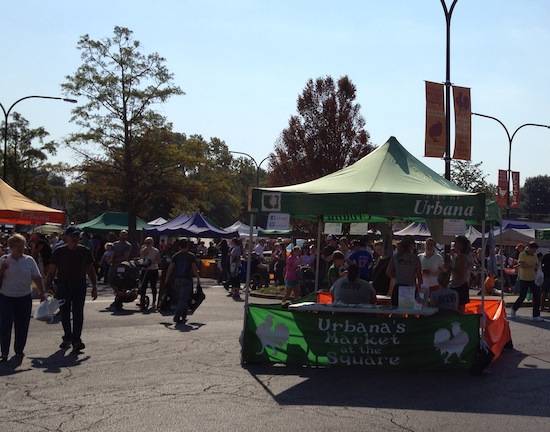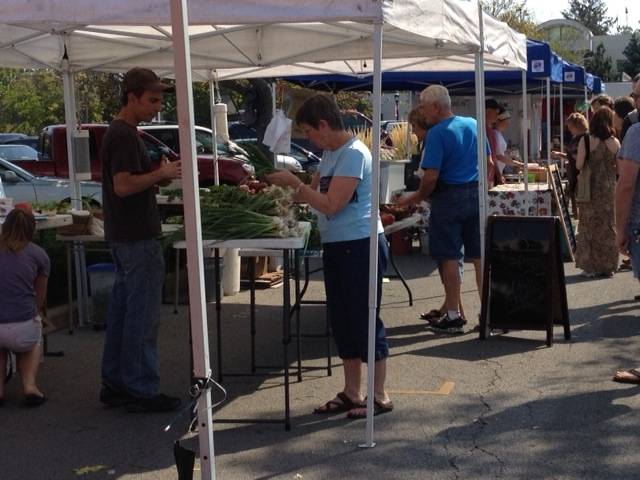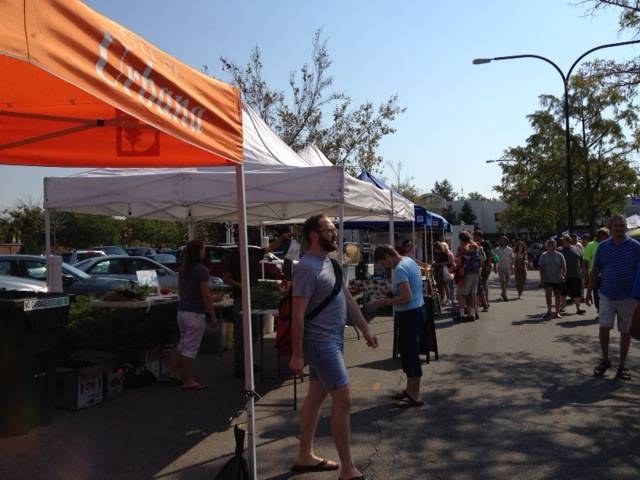Lisa Bralts-Kelly has been the City of Urbana Market Director for the Urbana Market at the Square for nearly five years. She’s leaving for another position in the community, so we talked to her about what coordinating the farmer’s market was like and how it has changed since she started. Bralts-Kelly’s last market day will be this weekend. Natalie Kenny-Marquez, the City’s Marketing Coordinator, will step in as the Interim Director for the rest of the season.
Smile Politely: What was the typical Saturday market morning like for you?
Lisa Bralts-Kelly: You come really early, and you direct people to their spaces. The more vendors you have the more cars you have … every week is different. That early part of the morning is pretty intense … It’s 45 minutes of total chaos, and then by 7 o’clock when patrons arrive it looks like the tents just sort of popped out of the parking lot like mushrooms, and all of the cars are out of the market.
My job during the day is to keep an eye on things. I’ve said before it’s like being the only server in a giant restaurant. People want you for a lot of things — vendors want to pay you or they want to know their schedule, and patrons want to know if a particular vendor is there or ‘why isn’t this vegetable or fruit in season right now.’

I also take a lot of photos at the market. I think the market is really well served by being represented visually, and people really respond to pictures of fruits and vegetables. I’m not a photographer. The food actually looks so good that you can just stick a camera in front of it.
The whole day is really spent running errands and making sure everything is running smoothly. [Behind the scenes] staff are running credit cards, selling merchandise, and answering patron questions. Like most people who run events, we feel like it’s a lot of work, but the best part is when people think it happens organically.
At the end of the day, it’s the second-most chaotic period. People are trying to leave, and usually if you drive past here at 2:00, most people are gone.
SP: I take it Saturday is kind of the fun day where you see the culmination of all the work that goes on during the week — what happens during the week to make that all happen?
LB-K: There are new applications coming in, there are questions about being a vendor, there are payments. We plan special events like Sprouts at the Market and Arts at the Market. We have logistics planning and social media promotion.

I also order merchandise and take inventory. Since the City of Urbana runs the Market, information about almost all of our programs is available at the market, so we want to make sure we have enough giveaway things, coloring books for the kids, things of that nature.
SP: How many vendors do you have?
LB-K: Registered vendors we have right now 160, but we’ll get more and different types as the weather cools. So I manage 160 vendor profiles, and some of these people only come one time, and some will be there all time, but most fall in the middle somewhere. In addition, we have over 60 community organizations registered; they take up some space in our fifth row. I probably have about 30 performers registered, but again not all those people are participating at once.
SP: How many vendors did you have when you started?
LB-K: We were averaging about 20 fewer a year, but one other thing that’s happened in addition to the increase in the number of vendors has been their increase in amount of space that they use, so they’ve gone from one space to two or two spaces to three, or vendors that only came one or two times are now coming more days. So we’ve had this increase in a couple of different ways — it’s also existing vendors building their capacity inside the market.
It can get interesting at the market at the beginning of the year — seniority is key, but we also want to reward punctuality.
SP: How many spaces do you have?
LB-K: Every space is the equivalent of a vehicular parking space. In terms of vendor space availability, we have about 200 spaces — ish. We’ve also created some spaces on the north side for community organizations that are smaller, but there are only 25 of those spaces. The farmer’s market is a farmer’s market, the primary driver is agriculture and commerce. Those are the things that, when we did our strategic plan over the past couple of years and developed our mission statement, those things definitely came out as being what people thought should be at the forefront of the market.

SP: You’ve been here a long time — do you have any favorite moments or memories?
LB-K: I’ve really enjoyed working with everyone out there. I think one of my favorite things we’ve done is create our kids programming Sprouts at the Market. It’s been fun to watch that grow. It’s also been fun to watch the coordinator, who’s a volunteer, who started as an undergraduate and now has her Masters in Dietetics and has really become an advocate for local food. We went from starting with 15–20 kids to anywhere between 80 and 100 kids that are actually signed up.
There’s always nutrition information, samples, information from the farmer that supplied the food that day.
This year, I’ve really enjoyed that we haven’t had a single day that has rained so far. Every year that I’ve been here, some more than others, we’ve had rain. I think in 2010, we had nine rain days. It affects the number of people who attend and the kind of vendors who come out. Even though it’s been hot, it’s been sunny and been lovely most of the day.
I really enjoy having Common Ground nearby, and I think there’s a lot of cross traffic that happens that’s a really positive thing. I see the market as sort of a gateway into local food culture here. They maybe think you have to be a member or a hippie or something to hang out there, but at the market, you can kind of hang back and everybody comes.
We’ve talked about doing cooking demonstrations out here too, but the permitting process is so complicated that I decided I would let that go. Vendors used to cook stuff on site, but the health department put a stop to that. It could be in the future that … Common Ground’s teaching kitchen could host demonstrations. There were cooking demonstrations before I was here where people would cook the food and have to throw it away, and that just killed me. Every health department is different and has different rules.

SP: Do you know why the health department has such strict rules here?
LB-K: I don’t. I’ve been to enough farmer’s market task forces and meetings to know that not every county or area is the same. Like the rules about eggs by our health department are different here than neighboring counties. That was one that came up this year. Somebody wanted to sell eggs and they were going to bring them in a cooler with dry ice, and in most counties that’s fine as long as you keep things to temperature — well, not even dry ice, regular ice — here you need mechanical refrigeration, which is a pretty big investment if you’re a small farmer and have to spend another $500 on a commercial-grade refrigerator, plus the power cost out here. It’s minimal, but it’s an additional cost.
So we’ve lost vendors out here because of that. It is what it is. The health department wants food to be safe, and the onus is on us to make sure that our vendors are on the up and up. I do wish there was a little more uniformity in the area, so that if we had people who wanted to come from Piatt County or Shelby County, they wouldn’t have to buy a completely different set of equipment to be here. It makes me sad, because we need more eggs at the market.
SP: How many people usually come to the market on a given Saturday?
LB-K: We count three times a day in two different ways, and we end up with nine numbers that get averaged all together. Obviously, if you don’t have a turnstile, you don’t know exactly how many people you have. I would say this year, because of the heat, we’re averaging around 5,000–6,000 people.
Another favorite thing at the market is that we started taking credit, debit, and the LINK card at the market in 2010. It brings people who were not otherwise able to use their benefits at the market.
SP: Were you involved much in food in the community before you started at the market?
LB-K: I worked for Common Ground, Eastern Illinois FoodBank, and then joined Common Ground’s board. I have been a market patron since I arrived here in 1996, but my intensive food involvement started in 2004, and I intend to remain involved.

SP: So what do you plan to do afterwards to stay involved?
LB-K: Well, the market is going to have an advisory board that will have at least one citizen … I’m not sure I’ll try to be that person. I’m sure I will be very engaged with the market, I still plan to attend the market, and now I’ll relieve my husband of the duty of trying to pick out vegetables at the market. Even though I haven’t been on the Common Ground board in a couple of years, I’m still involved with them.
I’m going to work for WILL, but I’m also a freelance correspondent and do radio segments every other week about food, neighborhoods, and DIY projects. I’ve always been a local food advocate, and I will continue working toward educating people about why it’s good to buy local.
The other work that I’ve done here, and that Natalie does, is economic development. We want to see small business entrepreneurs succeed, so the market is a really great place to develop those businesses. Occasionally you see a brick and mortar business coming out of the market, or a food truck — we’ve been a big supporter of food trucks at the market for years.
I’m pro-Urbana and I like to see things succeed here; even as a customer, I’ll be spending all of my money here with these people. I’m cool with that.
SP: Does the city plan to make any changes?
LB-K: I don’t think so. We all want to keep it running as smoothly as possible until November. Natalie, right away, was able to say she’d come in and take over as the Interim Director.
————————-
For more information about the market or what vendors or produce will be at the market this week, visit their Facebook page.
The last day of the market is November 3.
The City of Urbana has been running the farmer’s market since the late 1990s, but the farmer’s market has been meeting in various places in Urbana since about 1978. Next year will be the 35 anniversary of the farmer’s market.








